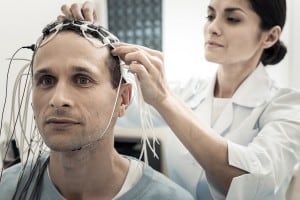Patients who experience a seizure should always visit a neurologist.
Dr. Jesus Martinez, neurologist at Regional One Health’s East Campus, said he orders an EEG for any patient who has had a seizure.
While an EEG doesn’t always show epilepsy, it is the best test for the disorder and can lead doctors to the proper treatment plan.
An EEG (electroencephalogram) is the main test neurologists use to diagnose epilepsy. But will the condition always show up on the scan?
According to Regional One Health neurologist Jesus Martinez, MD, “The answer is no, because sometimes abnormalities only show up right before or during a seizure. However, there is a lot we can learn from an EEG, and it’s always better to have a normal EEG than an abnormal EEG.”
That doesn’t mean the test isn’t crucial for patients who suffer seizures. Dr. Martinez orders an EEG for every patient with seizures.
During the test, small metal discs are attached to the scalp. Thin wires called electrodes measure electrical activity in the brain and send the results to a computer.
Abnormal brain wave activity is a sign of epilepsy. Dr. Martinez said the test can indicate if the patient has focal or generalized epilepsy.
Focal or partial epilepsy affects one hemisphere of the brain. Dr. Martinez said it is usually due to a stroke, tumor or trauma. Symptoms usually include seizures and depend on which center of the brain is impacted. Patients may lose awareness, stare or experience hallucinations.

Dr. Jesus Martinez said an EEG doesn’t always show if a patient has epilepsy, but it is the best tool available for diagnosis and treatment of the condition.
Generalized epilepsy is genetic and involves both hemispheres of the brain. Patients can suffer full seizures where they shake and lose consciousness.
Or, they can have an “absence seizure” where they may stare into space and do repetitive movements.
Dr. Martinez said an EEG that shows whether a patient has focal or generalized epilepsy arms doctors with a lot of important information.
Treatment for the two types of epilepsy differ. So, knowing the type helps physicians determine which medications or procedures are most likely to help.
But in some cases, patients are suffering seizures but have a normal EEG.
Dr. Martinez said an EEG only shows the electrical activity happening in the brain at the time of the test.
If you only have unusual activity during a seizure, the EEG may not provide a diagnosis.
In many cases, Dr. Martinez helps patients arrange for an outpatient extended EEG.
An outpatient extended EEG is done in a patient’s home. Doctors and nurses set up equipment to monitor the patient’s brain activity for two to five days.

Dr. Martinez has special training in epilepsy and can help patients navigate the condition using various treatment options.
“We use portable equipment so they don’t have to be in bed the whole time,” Dr. Martinez said. “They need to stay at home, but they can be up walking around.”
The other option is admitting the patient to the hospital for extended monitoring.
Patients who experience seizures should always see a neurologist. Dr. Martinez earned a fellowship in experimental/clinical epilepsy and neurophysiology at University of Virginia.
He uses that special expertise to help epilepsy patients improve their quality of life.
He can walk patients through treatment options including medication, Vagus Nerve Stimulation and surgery.